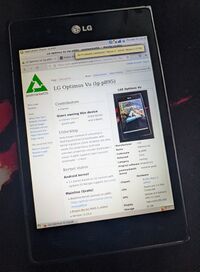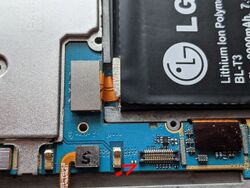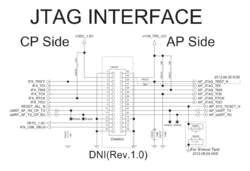LG Optimus Vu (lg-p895)
| This device is supported as part of a generic port. Refer to Nvidia Tegra armv7 (nvidia-tegra-armv7) for installation instructions and more information. |
 Optimus Vu in recursion | |
| Manufacturer | LG |
|---|---|
| Name | Optimus Vu |
| Codename | lg-p895 |
| Released | 2012 |
| Type | handset |
| Hardware | |
| Chipset | Nvidia Tegra 3 (AP33) |
| CPU | Quad-core 1.5 GHz Cortex-A9 |
| GPU | NVIDIA ULP GeForce GPU 12 cores |
| Display | 768×1024 IPS LCD |
| Storage | 32 GB |
| Memory | 1 GB |
| Architecture | armv7 |
| Software | |
Original software The software and version the device was shipped with. |
Android 4.0 |
Extended version The most recent supported version from the manufacturer. |
Android |
| FOSS bootloader | yes |
| postmarketOS | |
| Category | community |
Pre-built images Whether pre-built images are available from the postmarketOS Installation page. |
no |
Mainline Instead of a Linux kernel fork, it is possible to run (Close to) Mainline. |
yes |
pmOS kernel The kernel version that runs on the device's port. |
mainline grate |
Unixbench score Unixbench Whetstone/Dhrystone score. See Unixbench. |
1079.2 |
| Generic port | Nvidia Tegra armv7 (nvidia-tegra-armv7) |
| Device package |
|
| Kernel package |
|
Flashing Whether it is possible to flash the device with pmbootstrap flasher. |
Works
|
|---|---|
USB Networking After connecting the device with USB to your PC, you can connect to it via telnet (initramfs) or SSH (booted system). |
Works
|
Internal storage eMMC, SD cards, UFS... |
Works
|
Battery Whether charging and battery level reporting work. |
Works
|
Screen Whether the display works; ideally with sleep mode and brightness control. |
Works
|
Touchscreen |
Works
|
| Multimedia | |
3D Acceleration |
Partial
|
Audio Audio playback, microphone, headset and buttons. |
Works
|
Camera |
Works
|
Camera Flash |
Works
|
| Connectivity | |
WiFi |
Works
|
Bluetooth |
Works
|
GPS |
Broken
|
NFC Near Field Communication |
Works
|
| Modem | |
Calls |
Untested
|
SMS |
Untested
|
Mobile data |
Untested
|
| Miscellaneous | |
FDE Full disk encryption and unlocking with unl0kr. |
Works
|
USB OTG USB On-The-Go or USB-C Role switching. |
Partial
|
| Sensors | |
Accelerometer Handles automatic screen rotation in many interfaces. |
Works
|
Magnetometer Sensor to measure the Earth's magnetism |
Works
|
Ambient Light Measures the light level; used for automatic screen dimming in many interfaces. |
Works
|
Proximity |
Works
|
Haptics |
Works
|
Power Sensor Sensor to monitor current, voltage and power. Not fuel gauge! |
Works
|
Primary Bootloader Whether it is possible to replace stock bootloader with U-Boot. |
Works
|
|---|---|
Secondary Bootloader Whether it is possible to chainload U-Boot from stock bootloader. |
Partial
|
Mainline Whether latest upstream versions of U-Boot are not broken and it is possible to use them. |
Works
|
Internal Storage Whether it is possible to boot from internal storage (e.g. eMMC or UFS). |
Works
|
USB Peripheral Whether it is possible to use device as a peripheral in U-Boot, e.g. for fastboot mode. |
Works
|
Display |
Works
|
Buttons Whether it is possible to navigate in boot menu or grub with volume and power buttons. |
Works
|
| This device is based on the Tegra 3. See the SoC page for common tips, guides and troubleshooting steps |
Contributors
- Clamor
Users owning this device
- Clamor (Notes: 2 devices running pmOS with Grate kernel and U-Boot)
Unlocking
Only known method of unlocking is flashing patched LG bootloader with kernel signature check disabled, but who needs this proprietary stuff with unknown properties (vendor bootloader I mean) if p895 supports open sourced bootloader - U-Boot.
Kernel status
Android kernel
- 3.1 kernel based on LG sources with updates till Nougat support (Kernel)
Mainline (Grate)
- Baseline kernel sources on p895: https://gitlab.com/grate-driver/linux
- Proper dts for P895 is added
- Version: 6.4.0-rc6
- Status: Boots. See status below.
Installation
Bootloader replacement
| WARNING: Bootloader replacement will erase all data on the device! |
LG bootloader is highly NOT recommended to use with pmOS. To switch to open source booloader you need to use P895 re-crypt zip, it can be found here https://github.com/clamor-s/wheelie/releases/tag/p895 (one with re-crypt in its name) and you MUST use native Linux, virtual machine and WSL will NOT work.
Unpack zip and cd into it. Plug your P895 to PC and reboot it with holding both and . If all is done correct lsusb should show ID 0955:7130 NVIDIA Corp. APX device. Instructions are in the commands file or you can see them below.
Now perform:
$ sudo ./wheelie --blob blob.bin
Wheelie 0.2 - Preflight for nvflash.
Copyright (c) 2011-2012 androidroot.mobi
========================================
Waiting for device in APX mode...
[=] Chip UID: 0x000000000000009
[=] RCM Version: 0x30001
[=] CPU Model: Tegra 3
[+] Sending bootloader...
Sending file: 100 %
[!] Done - your device should now be ready for nvflash
$ sudo ./nvflash --resume --rawdevicewrite 0 1024 repart-block.bin --go
Nvflash v1.13.87205 started
[resume mode]
sending file: repart-block.bin
/ 4194304/4194304 bytes sent
repart-block.bin sent successfully
If phone did not reboot automatically, force reboot with holding . This will replace LG bootloader with u-boot. For more deep look into u-boot actions refer to dedicated section below.
postmarketOS installation
| WARNING: U-Boot mode is heavy power consuming, do not stay in it for prolonged periods of time! |
Thanks to u-boot you have installed on previous step, entire p895 eMMC can be mounted as a simple storage device.
Boot into u-boot bootmenu by holding and . Then using volume buttons you can navigate bootmenu and using choose its entries.
Plug your p895 to PC and choose mount internal storage. Your p895 eMMC should be detected by PC as a simple mass storage. Then it can be flashed as any SD card using pmbootstrap.
Hardware status (mainline)
| Status | Hardware | Info |
|---|---|---|
| Y | Booting | Android style boot.img has restriction of approx 4 MB, which is fraction of /boot partition size. |
| Y | Bootloader | Open source bootloader U-Boot is available as alternative for stock LG bootloader and can replace it. U-Boot can not boot downstream kernel if it has Trusted Foundations enabled. |
| Y | Panel | KOE/Hitachi TX13D100VM0EAA MIPI DSI LCD IPS panel via Solomon SSD2825 DSI/LVDS bridge. |
| Y | Backlight | TI LM3533 led controller is used for main backlight. Driver is converted into OF and can be operated by panel. |
| N | HDMI output | Device supports MHL via SII9244 hdmi bridge on it own i2c-gpio line. Currently not configured. Is similar to SII9234 driver but is not same, requires hw setup look. MHL connection is detected. |
| Y | Touchscreen | Synaptics RMI4 S3203B touchscreen is used. |
| N | Touch buttons | Synaptics RMI4 S3204B touchscreen's function 1a is used. It is ported and set, but currently capacitive buttons still do not work. |
| Y | USB | USB functional is fully implemented. Due to hw design HOST state can work only via OTG-Y cable (with external power). PERIPHERAL works perfectly fine. |
| Y | Internal memory | eMMC 32 Gb by Hynix model HBG4e. |
| P | GPS | Some fancy GSD5T GNSS module. Kernel part is ready but there is no way to test it since most of gps processing is made in userspace. |
| Y | WiFi | Uses BCM4330B1. Wi-Fi should work out of the box (best with IWD daemon: apk add iwd; rc-update del wpa_supplicant; rc-update add iwd). All needed stuff is included. Device may not connect to some networks (in my case it was PC hotspot, to fix this, I have installed IWD on my PC as well). Be aware that WiFi MAC address is not static, though it should not matter for average user. |
| Y | Bluetooth | BCM4330B1 37.4 MHz Class 1.5 W-ExtLNA PCM-S. Works perfectly fine with included firmware. |
| Y | NFC | As on most devices of this age PN544 is used. Recognizes NFC tags. |
| Y | GPIO keys/switches | There are 4 GPIO keys: Power, Volume up, Volume down and Memo keys. |
| Y | GPIO leds | There are 2 GPIO leds: Power button led and Keypad led bound and work via sysfs. Power led acts as charging indicator but has enormously big delays. Keypad led is not active till capacitive buttons are fixed. |
| Y | Vibro | Immersion ISA1200 haptic engine. Basic set of modes is implemented via Force Feedback Linux API. |
| Y | Battery | MAX17040 fuel gauge is used. Fully set up. |
| Y | Charger | Maxim MAX8971 charger is used. Fully configured, supports both slow and fast charging. Re-plug charger after exit from suspend, else it will charge with 360 mA current. |
| Y | Extcon | Maxim MAX14526 MUIC is used. Can detect a big range of devices, usb host/peripheral, AC charger, MHL cable etc. |
| Y | PMIC | Optimus Vu uses Maxim MAX77663 PMIC mfd. Media devices have own sub-PMIC TI LP8720. |
| Y | Sound | Sound codec is Maxim MAX98089. Fully routed in kernel, UCM's are complete for media and calls. Audio via HDMI should work out of the box. |
| Y | Thermal sensor | NCT1008 ON Semiconductor LM90 series thermometer and Tegra T sensor. Both work perfectly fine. |
| Y | Power sensor | Ina230 works fine. Battery has its own tsc2007 ADC to detect battery temperature, works as current sensor. |
| Y | Orientation sensors | Include mpu6050 imu (accelerometer, gyroscope and thermometer) and ami306 compass. |
| Y | Light and Proximity sensor | APDS990X - combined AL and proximity sensor is used. Both functions work fine. Proximity function is disabled by default. |
| Y | Front camera | 1.26 MP Aptina 1/6" HD SOC (MT9M114). RAW and YUV output via v4l2-ctl. |
| Y | Rear camera | 8 MP Sony imx111 1/4" BSI sensor with DW9714 lens voice coil and LM3559 flash led. DW9714 and LM3559 both have mainline drivers, imx111 is in mainlining process. RAW output via v4l2-ctl. |
| Y | Modem | Intel XMM6260 modem is connected to usb2 line in HSIC mode. It is detected, but needs userspace configuration. |
| P | ULP GeForce | GPU Acceleration partially works. |
Usability
Desktop environment
Since 3D acceleration is not available yet, all DE which use it will be painfully slow and laggy.
Currently xfce4 or mate are recommended.
U-Boot
Current U-Boot status on LG Optimus Vu
| Status | Feature | Info |
|---|---|---|
| Y | Primary bootloader | U-Boot successfully boots when is flashed into EBT partition instead of LG bootloader. Can be additionally booted via fusée gelée exploit. |
| P | Secondary bootloader | U-Boot can be chainloaded from both /boot and /recovery partitions, though LG bootloader has some conflicts with U-Boot. |
| Y | Panel | Solomon SSD2825 bridge, Hitachi KOE TX13D100VM0EAA DSI panel, TI lm3533 backlight were all added into U-Boot. Panel is fully functional. |
| Y | eMMC | Re-partitioned to better fit generic setup. Can be mounted as mass storage on host PC. |
| Y | Boot kernel | Yes, and can be highly adjusted with extlinux.conf. |
| Y | Boot menu | Native u-boot bootmenu works perfectly fine. It can be called with pressing volume down button on boot. |
| Y | Power management | Offline charging and charging in u-boot both work and are hw configured. Both power off and reboot options work and are available in bootmenu. If no valid kernel is found phone will turn off. |
| Y | Fastboot | Fastboot option is available in bootmenu. Most functions should work fine. |
| P | Boot Android | Booting Android kernel can be performed only same way mainline kernel boots. Additionally it must not have CONFIG_TRUSTED_FOUNDATIONS = y and some additional small patches, it can be booted by u-boot. |
| Y | Self update | Self update option is implemented and write is done correctly. Bootloader file has to have name u-boot-dtb-tegra.bin and be placed on 1st partition of eMMC. |
Gallery
Serial console


LG Optimus Vu is an interesting device since it has factory soldered jtag directly on motherboard in pretty apposite and easily accessible place. To get to jtag you need only to take off back cover and plastic casing over motherboard. That is it, only one free socket is jtag. UART is UART-D (serial@70006300; 115200n8) and uses 3.3v.
See also
- More about the device Wikipedia entry




